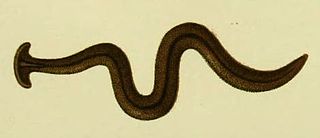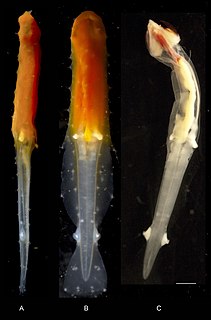
The Chaetognatha or chaetognaths are a phylum of predatory marine worms that are a major component of plankton worldwide. Commonly known as arrow worms, about 20% of the known Chaetognatha species are benthic, and can attach to algae and rocks. They are found in all marine waters, from surface tropical waters and shallow tide pools to the deep sea and polar regions. Most chaetognaths are transparent and are torpedo shaped, but some deep-sea species are orange. They range in size from 2 to 120 millimetres.

Georg Ludwig Ritter von Trapp was an Austro-Hungarian naval officer who later acquired U.S. citizenship. He was the patriarch of the Trapp Family Singers, whose lives were the inspiration for the musical play and film The Sound of Music. His naval exploits during World War I earned him numerous decorations, including the Military Order of Maria Theresa. Under his command, the submarines SM U-5 and SM U-14 sank 13 Allied ships totaling about 45,669 gross register tons (GRT).

Heinz von Foerster was an Austrian American scientist combining physics and philosophy, and widely attributed as the originator of Second-order cybernetics. He was twice a Guggenheim fellow and also was a fellow of the American Association for the Advancement of Science, 1980. He is well known for his 1960 Doomsday equation formula published in Science predicting future population growth.

The Bismarck Archipelago is a group of islands off the northeastern coast of New Guinea in the western Pacific Ocean and is part of the Islands Region of Papua New Guinea. Its area is about 50,000 square km.

Franz Ritter von Hauer, or Franz von Hauer, was an Austrian geologist.
GeorgWickram was a German poet and novelist.
Eukrohniidae is a family of sagittoideans in the order Phragmophora. It consists of a single genus, Eukrohnia von Ritter-Záhony, 1909.

The Ghetaldi was a noble family of the Republic of Ragusa.

Záhony is a town in Szabolcs-Szatmár-Bereg county, in the Northern Great Plain region of eastern Hungary.

Bipalium is a genus of large predatory land planarians. They are often loosely called "hammerhead worms" or "broadhead planarians" because of the distinctive shape of their head region. Land planarians are unique in that they possess a "creeping sole" on their ventral side. Several species are considered as invasive to the United States and to Europe. Some studies have begun the investigation of the evolutionary ecology of these invasive planarians.
Jean Laforgue was a French scholar living in Dresden, mainly known for having edited and censored the first edition of Giacomo Casanovas memoirs, Histoire de ma vie.
The Geneva Camerata (GECA), is an orchestra composed of forty international musicians of the young generation. Based in Geneva, it performs music of all periods and styles, from early baroque music to contemporary music, as well as jazz, rock, world music, electronic music, in addition to creating a variety of multidisciplinary projects involving dance, theatre, and visual arts.

Parasagitta is a genus of arrow worms in the family Sagittidae. At one time these arrow worms were classified in the genus Sagitta.

Humbertium is a genus of land planarians of the subfamily Bipaliinae.
Krohnittidae is a family of chaetognaths in the order Aphragmophora. It consists of a single genus, Krohnitta von Ritter-Záhony, 1910.
Spadellidae is a family of sagittoideans in the order Phragmophora. Spadellidae prey on plankton and commonly reside in the epipelagic zone of the ocean.

Archeterokrohnia is a genus of chaetognaths in the family Heterokrohniidae.The total body length excluding tail fin 28.5; the tail section is 55.2% of the tail fin; head blunt when hooded, triangular after preservation, head with 3.5 mm. Furthermore, the eyes are absent, the trunk section is orange throughout in life, and the organism exists around 3200 m below sea level.
Heterokrohnia is a genus of chaetognaths in the family Heterokrohniidae.
Eukrohnia fowleri is a deep-sea marine arrow worm. It is the only known bioluminescent member of the genus Eukrohnia, and one of the two known species of bioluminescent arrow worms, the other being the distantly related Caecosagitta macrocephala. The bioluminescent organ of Eukrohnia Fowlery is found along the center of its tail fin on both its dorsal and ventral side. It has a secreted bioluminescence that is thought to be coelenterazine based. While both species use luciferases in conjunction with coelenterazine for light emission, the luciferase of Eukrohnia fowleri is highly stable after 30 minutes while the luciferase of Caecosagitta macrocephala becomes inactive. So far, there is no other bioluminescent organism that uses hexagonal packing in order to hold bioluminescent materials/ E. fowleri evolved through the adaptation to hypoxic water and due to the recent oxygenation of water they have been experiencing bottleneck events. These events have been seen as one of the reasons that E. fowleri have such low biodiversity.
Xenokrohnia is a genus of chaetognaths in the family Heterokrohniidae. It consists of one species, Xenokrohnia sorbei Casanova, 1993, which lives in a marine environment. The initial discovery was made from six specimens found in a deep-sea search in the Bay of Biscay for Spadella equidentata Casanova, 1987. A uniquely large (ventral) secretory gland, separate from other chaetognaths, defined the new genus and species. The gland, which is likely used to rid the body of digestive fluids, is probably due to the unique feeding habits of the species; these may include scavenging habits. The presence of an unusual and seemingly superfluous digestive utility is similar to Archeterokrohnia palpifera Casanova, 1986, which have a larger pair of pedipalps then what is common for chaetognaths.











